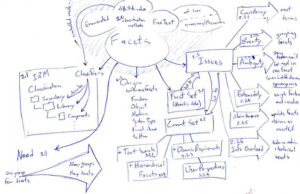5.9: Text- Prewriting Strategies
- Page ID
- 59097
The term “pre-writing” conjures up a lot of strange activities and practices. You’ve probably tried many different prewriting strategies in the past, and may have a good idea of what works for you and what doesn’t.
Keep in mind that the KIND of writing project you’re working on can impact how effective a particular technique is to use in a given situation. Something that you’ve relied on before may not be as effective as you move into new subjects. Experiment often.
Make it fun! Here are some to try:
Freewriting
 Set a timer for a short amount of time (5 minutes or 10 minutes are good options). During that period, write anything that comes to mind related to your topic. The goal is to not worry about what comes out of your pen or keyboard. Instead, just free your mind to associate as it wishes. It’s amazingly productive for rich ideas, and it’s nice not to have to worry about spelling and grammar.
Set a timer for a short amount of time (5 minutes or 10 minutes are good options). During that period, write anything that comes to mind related to your topic. The goal is to not worry about what comes out of your pen or keyboard. Instead, just free your mind to associate as it wishes. It’s amazingly productive for rich ideas, and it’s nice not to have to worry about spelling and grammar.
If it’s hard for you to “turn off” the worry about writing well, challenge yourself to write a few awful, terrible sentences as the beginning.
List-Making
 If you’re a list-maker by nature, there’s no reason not to harness that for academic writing purposes. Jot notes about major ideas related to the subject you’re working with. This also works well with a time limit, like 10 minutes. A bonus feature–after you’ve had time to reflect on your list, you can rearrange it in hierarchical order, and create a basic outline quickly.
If you’re a list-maker by nature, there’s no reason not to harness that for academic writing purposes. Jot notes about major ideas related to the subject you’re working with. This also works well with a time limit, like 10 minutes. A bonus feature–after you’ve had time to reflect on your list, you can rearrange it in hierarchical order, and create a basic outline quickly.
Clustering
 Also known as “mapping,” this is a more visual form of brainstorming. It asks you to come up with topic ideas, and draw lines to connect ideas and figure out sub-categories and related ideas. You can end up with a quite extensive “bubble cloud” as a result. This also works well within a time limit, like 10 minutes.
Also known as “mapping,” this is a more visual form of brainstorming. It asks you to come up with topic ideas, and draw lines to connect ideas and figure out sub-categories and related ideas. You can end up with a quite extensive “bubble cloud” as a result. This also works well within a time limit, like 10 minutes.
Questioning
 The way to find answers is to ask questions–seems simple enough. This applies to early-stage writing processes, just like everything else. When you have a topic in mind, asking and answering questions about it is a good way to figure out directions your writing might take.
The way to find answers is to ask questions–seems simple enough. This applies to early-stage writing processes, just like everything else. When you have a topic in mind, asking and answering questions about it is a good way to figure out directions your writing might take.
Start with just listing the questions. What do you want or need to know the answers to regarding your topic?
Dialoging
 Another approach to getting inside a topic is to imagine two people talking about it. Write out a script for two characters you invent. Give them names and brief personalities–why are they interested in this subject? Assume one of them knows more than the other about it.
Another approach to getting inside a topic is to imagine two people talking about it. Write out a script for two characters you invent. Give them names and brief personalities–why are they interested in this subject? Assume one of them knows more than the other about it.
An option is to find another person to participate with you. Write down a back and forth conversation you have about the topic. Try texting or emailing one another to make it feel authentic.
- Revision and Adaptation. Provided by: Lumen Learning. License: CC BY: Attribution
- Prewriting Strategies. Authored by: Alexis McMillan-Clifton. Provided by: Tacoma Community College. Located at: http://www.tacomacc.edu. License: CC BY: Attribution
- Image of pencil. Authored by: William Warby. Located at: https://flic.kr/p/r1rX9h. License: CC BY: Attribution
- Image of list. Authored by: Lucy Downey. Located at: https://flic.kr/p/bD58mM. License: CC BY: Attribution
- Image of mind map. Authored by: Jason Morrison. Located at: https://flic.kr/p/4heZif. License: CC BY-NC: Attribution-NonCommercial
- Image of question. Authored by: Deans_Icons. Located at: https://pixabay.com/en/speech-bubble-comic-icon-symbol-1426772/. License: CC0: No Rights Reserved
- Image of two figures talking. Authored by: josemiguels. Located at: https://pixabay.com/en/conversation-dialogue-interview-1262311/. License: CC0: No Rights Reserved

